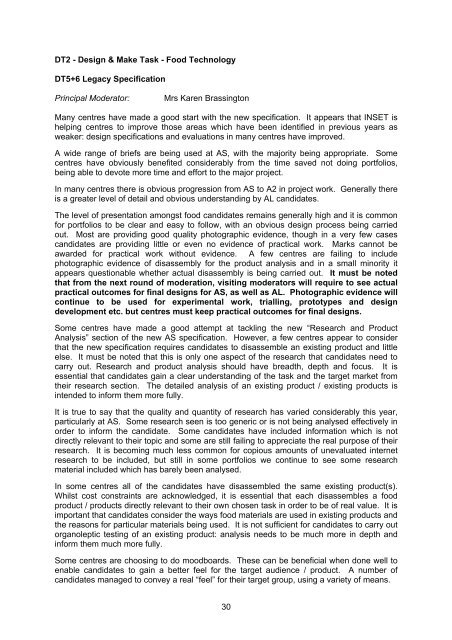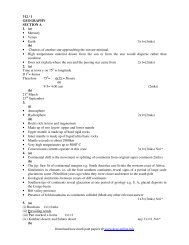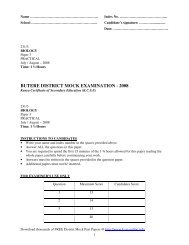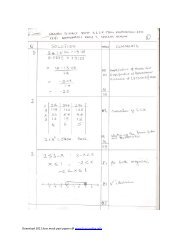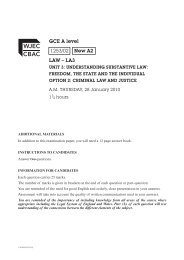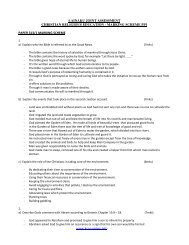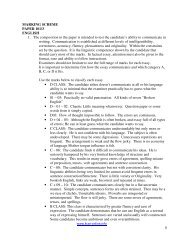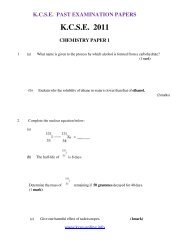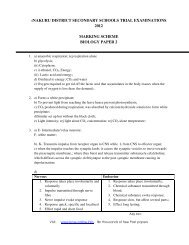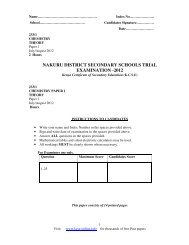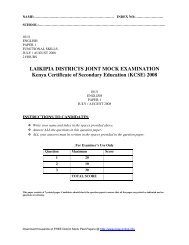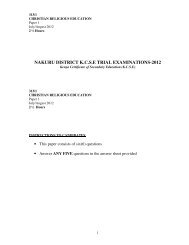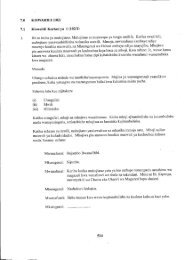GCE D&T Legacy Examiners Report 2009 - kcse past papers | 2013 ...
GCE D&T Legacy Examiners Report 2009 - kcse past papers | 2013 ...
GCE D&T Legacy Examiners Report 2009 - kcse past papers | 2013 ...
Create successful ePaper yourself
Turn your PDF publications into a flip-book with our unique Google optimized e-Paper software.
DT2 - Design & Make Task - Food Technology<br />
DT5+6 <strong>Legacy</strong> Specification<br />
Principal Moderator:<br />
Mrs Karen Brassington<br />
Many centres have made a good start with the new specification. It appears that INSET is<br />
helping centres to improve those areas which have been identified in previous years as<br />
weaker: design specifications and evaluations in many centres have improved.<br />
A wide range of briefs are being used at AS, with the majority being appropriate. Some<br />
centres have obviously benefited considerably from the time saved not doing portfolios,<br />
being able to devote more time and effort to the major project.<br />
In many centres there is obvious progression from AS to A2 in project work. Generally there<br />
is a greater level of detail and obvious understanding by AL candidates.<br />
The level of presentation amongst food candidates remains generally high and it is common<br />
for portfolios to be clear and easy to follow, with an obvious design process being carried<br />
out. Most are providing good quality photographic evidence, though in a very few cases<br />
candidates are providing little or even no evidence of practical work. Marks cannot be<br />
awarded for practical work without evidence. A few centres are failing to include<br />
photographic evidence of disassembly for the product analysis and in a small minority it<br />
appears questionable whether actual disassembly is being carried out. It must be noted<br />
that from the next round of moderation, visiting moderators will require to see actual<br />
practical outcomes for final designs for AS, as well as AL. Photographic evidence will<br />
continue to be used for experimental work, trialling, prototypes and design<br />
development etc. but centres must keep practical outcomes for final designs.<br />
Some centres have made a good attempt at tackling the new “Research and Product<br />
Analysis” section of the new AS specification. However, a few centres appear to consider<br />
that the new specification requires candidates to disassemble an existing product and little<br />
else. It must be noted that this is only one aspect of the research that candidates need to<br />
carry out. Research and product analysis should have breadth, depth and focus. It is<br />
essential that candidates gain a clear understanding of the task and the target market from<br />
their research section. The detailed analysis of an existing product / existing products is<br />
intended to inform them more fully.<br />
It is true to say that the quality and quantity of research has varied considerably this year,<br />
particularly at AS. Some research seen is too generic or is not being analysed effectively in<br />
order to inform the candidate. Some candidates have included information which is not<br />
directly relevant to their topic and some are still failing to appreciate the real purpose of their<br />
research. It is becoming much less common for copious amounts of unevaluated internet<br />
research to be included, but still in some portfolios we continue to see some research<br />
material included which has barely been analysed.<br />
In some centres all of the candidates have disassembled the same existing product(s).<br />
Whilst cost constraints are acknowledged, it is essential that each disassembles a food<br />
product / products directly relevant to their own chosen task in order to be of real value. It is<br />
important that candidates consider the ways food materials are used in existing products and<br />
the reasons for particular materials being used. It is not sufficient for candidates to carry out<br />
organoleptic testing of an existing product: analysis needs to be much more in depth and<br />
inform them much more fully.<br />
Some centres are choosing to do moodboards. These can be beneficial when done well to<br />
enable candidates to gain a better feel for the target audience / product. A number of<br />
candidates managed to convey a real “feel” for their target group, using a variety of means.<br />
30


